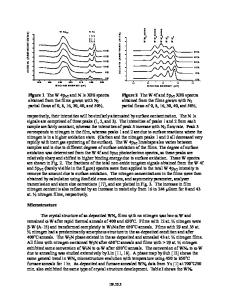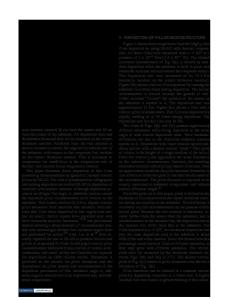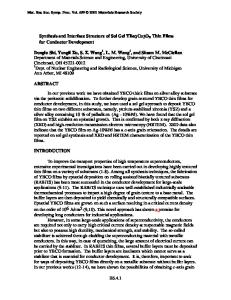Microstructure development of HfO x thin films
- PDF / 1,132,060 Bytes
- 7 Pages / 612 x 792 pts (letter) Page_size
- 82 Downloads / 380 Views
Microstructure development of HfOx thin films Eliane F. Chinaglia and Luis H. Avanci Physics Department, Centro Universitário da FEI Av. Humberto de Alencar Castelo Branco, 3972 09850-901, São Paulo, Brazil
ABSTRACT Morphological and crystallographic characteristics of HfOx with different oxygen concentrations (0 x 2.5) and thicknesses (18 nm t 310 nm) were analyzed in this work before and after thermal annealing at 700oC in N2 atmosphere for 1h. The morphology of the asdeposited, low oxygen concentration films (t = 100 nm) is formed by a well-defined granular structure with grains around 20 nm in diameter. For higher oxygen concentration, the roughness increases, as a consequence of a very porous surface morphology. At the same time, the crystallographic structure changes from HCP with a {0002} preferred orientation to an amorphous structure as oxygen concentration increases. As the thickness of the HfO2 films increases, we also observed the formation of a high surface porosity, with pore diameter ranging from 80 nm to 120 nm. The changes observed in morphology and crystallinity of the films, as we increase the concentration of contaminants, occurs because of the lowering of the adatoms surface diffusion, which prevents them from reaching lower energy points during the formation of the microstructure of the films. Furthermore, this lowered surface diffusion favors the process of grain renucleation, which leads to roughness increasing, and to an enhancement of the formation of porous surfaces. After annealing, all films exhibit the monoclinic crystallographic phase associated with HfO2. Surface morphology of the films is consistent with a polycrystalline structure with grain diameters varying between 10 nm and 200 nm. As their size increases, the grains become very faceted, a finding consistent with the improvement in film crystallinity. Our results suggest that long-time annealing promotes the diffusion of oxygen from the SiO2-Hf interface to the film, compensating any O2 deficit in the film. Formation of the monoclinic phase is also favored by the improvement in the film stoichiometry promoted by thermal treatment. Also, the critical size of the nuclei, associated with a grain growth in a particular crystallographic orientation, decreases as a consequence of the high temperature during thermal annealing. Therefore, formation of faceted grains and increasing of surface roughness are favored in thicker films.
INTRODUCTION Oxide thin films have been extensively studied due to their notable properties. Among the oxide films, HfO2 dielectric thin films are the most promising materials for the development of nanoelectronic devices. This material has been widely studied due to its optical properties (high refractive index, transparent to radiation from ultraviolet to infrared), electrical properties (high dielectric constant), thermal properties (its high melting point allows its use as a thermal barrier), etc. [1-6].
The properties of thin films are strongly dependent on the microstructure, which in turn depends on
Data Loading...











